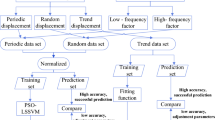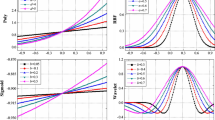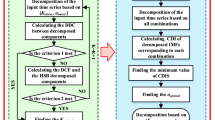Abstract
The evolution of landslides is influenced by internal geological conditions and external trigger factors such as the precipitation and the change of groundwater level. It’s difficult to establish a precise physical model to predict the happening of landslides on account of the complex and unobtainable internal mechanisms. Meanwhile, development of advanced real-time monitoring system has challenged engineers to detect and analyze valuable features from high amount of data of the status of slopes. Multivariate data-based models have been applicable to the early warning of landslides. In the current paper, cumulative displacement was decomposed into trend components and periodic components by Ensemble Empirical Mode Decomposition (EEMD) method. Based on abundant monitoring data, the trend displacement was predicted by polynomial function, while the periodic displacement was predicted by Particle Swarm Optimization and Support Vector Machine (PSO-SVM) model. A high and steep slope along the express way in Zhejiang province, China was taken as a case study. The model proposed in the current paper has been demonstrated to be highly accurate in predicting the displacement of rainfall-induced landslides.
Access provided by CONRICYT-eBooks. Download conference paper PDF
Similar content being viewed by others
Keywords
1 Introduction
The evolution of landslides is influenced by internal geological conditions and external trigger factors such as the precipitation and the change of groundwater level. It’s difficult to establish a precise physical model to predict the happening of landslides on account of the complex and unobtainable internal mechanisms. Therefore, data-based models have been widely used in practical engineering.
Predicting the displacement of landslides is a significant work in the early warning system. Numerous data-based models have been proposed to solve this problem, such as Artificial Neural Network (ANN) [1], Support Vector Machines (SVM) [2] and Extreme Learning Machine (ELM) [3]. Among these models, SVM is widely used and has achieved good performance in predicting the displacement [4].
In this paper, a short-term prediction was conducted by SVM models using daily data rather than monthly data. A case study was taken to estimate the performance of models with different input data.
2 Methodology
In the current paper, a high and steep slope along the express way in Zhejiang province, China was taken as a case study. The cumulative displacement of this landslide was decomposed into trend components and periodic components by Ensemble Empirical Mode Decomposition (EEMD) method. Based on abundant monitoring data, the trend displacement was predicted by polynomial function, while the periodic displacement was predicted by three SVM models (Grid-SVM, GA-SVM, PSO-SVM). Each model contains 4 types of combination of input data as shown in Table 1. Root mean square error (RMSE) and correlation coefficient (R2) were taken as the indexes to estimate the performance of these models.
3 Results and Data Analysis
The landslide we researched in this study is a typical rainfall-induced landslide as we can see in Fig. 1. The displacement developed slowly in the dry season, while grew rapidly in the wet season, especially in May and June. Rainfall is the crucial trigger factor of the evolution of this landslide. 100 sets of daily data (from 2016/3/6 to 2016/6/13) were selected to test the models. The first 80 sets were training data and the rest were test data.
Figure 2 shows the predicted periodic displacement of 12 models. With input data of only displacement in the prior 3 days, Grid-SVM-1 and GA-SVM-1 model cannot fit the original curve very well. Grid-SVM-4 and GA-SVM-4 have the best performance of prediction as shown in Table 2. The accuracy increased with more input data of rainfall.
Comparison of predicted periodic displacement of different models: (a) Periodic displacements predicted by Grid-SVM models. (b) Periodic displacements predicted by GA-SVM models. (c) Periodic displacements predicted by PSO-SVM models. (d) Periodic displacements predicted by Grid-SVM-4, GA-SVM-4, PS-SVM-4.
Compared to the Grid-SVM model and GA-SVM model, PSO-SVM model has better forecast capacity. Four PSO-SVM models all have accurate prediction of periodic displacement. Similarly, the accuracy of PSO-SVM models also increased slightly with more input data of rainfall as shown in Table 2.
In summary, the PSO-SVM model has better forecast capacity than the Grid-SVM model and GA-SVM model. Input data with rainfall in the prior 5 days can increase the accuracy of SVM models evidently.
4 Conclusion
Multivariate data-based model is a powerful tool in predicting the displacement of landslides. As the crucial trigger factor, rainfall data can increase the accuracy of prediction models evidently. The forecast capacity of PSO-SVM model is better than Grid-SVM model and GA-SVM model especially in the wet season.
The whole process proposed in this study with PSO-SVM model has a high accuracy in predicting the displacement of rainfall-induced landslides which can contribute to the early warning of landslides.
References
Mayoraz, F., Vulliet, L.: Neural networks for slope movement prediction. Int. J. Geomech. 2(2), 153–173 (2002)
Zhou, C., Yin, K., Cao, Y., Ahmed, B.: Application of time series analysis and PSO–SVM model in predicting the Bazimen landslide in the Three Gorges Reservoir. China. Eng. Geol. 204, 108–120 (2016)
Huang, F., Huang, J., Jiang, S., Zhou, C.: Landslide displacement prediction based on multivariate chaotic model and extreme learning machine. Eng. Geol. 218, 173–186 (2017)
Zhu, X., Xu, Q., Tang, M., Nie, W., Ma, S., Xu, Z.: Comparison of two optimized machine learning models for predicting displacement of rainfall-induced landslide: a case study in Sichuan Province, China. Eng. Geol. 218, 213–222 (2017)
Author information
Authors and Affiliations
Corresponding author
Editor information
Editors and Affiliations
Rights and permissions
Copyright information
© 2018 Springer Nature Switzerland AG
About this paper
Cite this paper
Wu, H., Dong, M., Gong, X. (2018). Application of Multivariate Data-Based Model in Early Warning of Landslides. In: Wu, W., Yu, HS. (eds) Proceedings of China-Europe Conference on Geotechnical Engineering. Springer Series in Geomechanics and Geoengineering. Springer, Cham. https://doi.org/10.1007/978-3-319-97112-4_167
Download citation
DOI: https://doi.org/10.1007/978-3-319-97112-4_167
Published:
Publisher Name: Springer, Cham
Print ISBN: 978-3-319-97111-7
Online ISBN: 978-3-319-97112-4
eBook Packages: EngineeringEngineering (R0)






